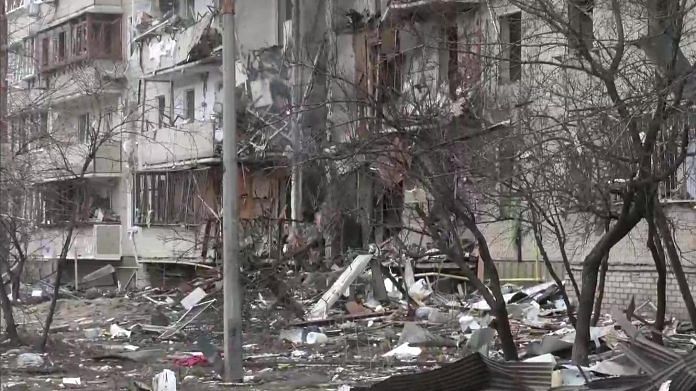For those shocked by images of Ukrainian civilians targeted by Russian air strikes, I have one word for you: Syria.
Moscow’s indiscriminate bombing campaign in Syria in support of President Bashar al-Assad’s brutal war against his own people — including attacks on hospitals, schools, residential neighborhoods and markets — killed thousands of civilians. Its year-long military offensive in the rebel-held province of Idlib in 2019 was particularly savage, forcing as many as 1.4 million people from their homes.
Photos emerged from the town of Binnish in Idlib on Feb. 24 showing a mural painted by local artists to protest Russia’s invasion of Ukraine and send a message of solidarity with those resisting it. No one knows better than Syrians what it’s like to live under the bombardment of Russian fighter jets. Even young children can look to the sky and identify which country is dropping missiles on their homes: Armed with longer range weaponry, the new Russian aircraft fly higher and therefore appear quieter than the old Soviet MiGs flown by the Syrian Air Force.
A United Nations report into atrocities committed in Syria published last year accused Russia of direct involvement in war crimes and a “systemic failure to take any precautions to spare civilians from harm.” Moscow’s entry into the war in Syria in 2015 turned the conflict in Assad’s favor, and provided a real-life testing ground for the weaponry now being used against Ukrainians.
So far, the number of civilian casualties in Ukraine is unclear, but evidence that heavy Russian shelling and air strikes have hit schools and apartment blocks is mounting, as tens of thousands huddle in the the safety of underground bunkers and subway platforms. Russia, meanwhile, says its troops are attacking only military targets.
Now there are fears that as Russia’s slower-than-expected military progress in Ukraine and the strong resistance it is facing may prompt it to unleash indiscriminate force, including the use of thermobaric bombs — weapons it inflicted on civilian neighborhoods in the Syrian city of Aleppo with devastating consequences. Their use in the Caucasus in 1999 leveled city blocks in Grozny. These unguided munitions disperse fuel into the air around the bomb moments before detonation, creating a huge fireball and a powerful shock wave that lasts longer than conventional explosives.
Their reported arrival in Ukraine last week, along with Russian troops and tanks, sent a chilling message.
While the specifics of Russia’s engagement in Syria are unlikely to be replicated elsewhere, there are already haunting similarities in Ukraine: Indiscriminate use of force, no respect for the law of armed conflict or international humanitarian law, and brutality against civilians, said Mona Yacoubian, a senior advisor for Syria, the Middle East and North Africa at the U.S. Institute of Peace.
There are also key differences in Putin’s thinking — he is painting Ukraine in existential terms, while his actions in Syria were more opportunistic, Yacobian told me. Still, elements of Russia’s endgame strategy for Syria might provide a template for its foreign-policy thinking today. “Russia believes we are in a post-West world and they are acting on that belief,” she said. Some Russian analysts consider Syria as Russia’s “first post-Soviet success”: “They prevented regime change and inflicted defeat over the U.S.”
Meantime, Russia has used its dominance in Syria to project its influence across the region, antagonizing NATO with its sale of the S-400 missile defense system to Turkey and effectively driving a wedge between Ankara and its NATO allies.
Now, of course, it’s turned its attention much closer to home. And just like Syrian civilians who have endured a terrifying decade or more of conflict, displacement, loss and terror, Ukrainians too are facing this awful reality. Thousands are fleeing to neighboring countries, just as more than 6.6 million Syrians have done before them.
So what did we learn from all this? The international community failed Syrians and that conflict, in turn, spilled over to Jordan, Turkey and Lebanon and then into Europe, as refugees made their way to a safer life. It showed us there is no effective international mechanism to protect a civilian population enduring the worst forms of violence and persecution. And it laid bare the impotence of the U.N. Security Council, where Russia and China routinely used their veto powers to prevent any intervention that would threaten Assad’s rule.
Those lessons hold true today. Russia vetoed a draft security council resolution on Ukraine on Friday, while the sentiments that President Volodymyr Zelenskiy has expressed these past few days — saying Ukraine has been “left alone” to face Moscow’s invasion — will ring true for Syrians who have been crying out for help for years. Yet again, we are letting history repeat.- Bloomberg
Also read: How restrictions on Russia using SWIFT system can affect economy of country, rest of Europe



